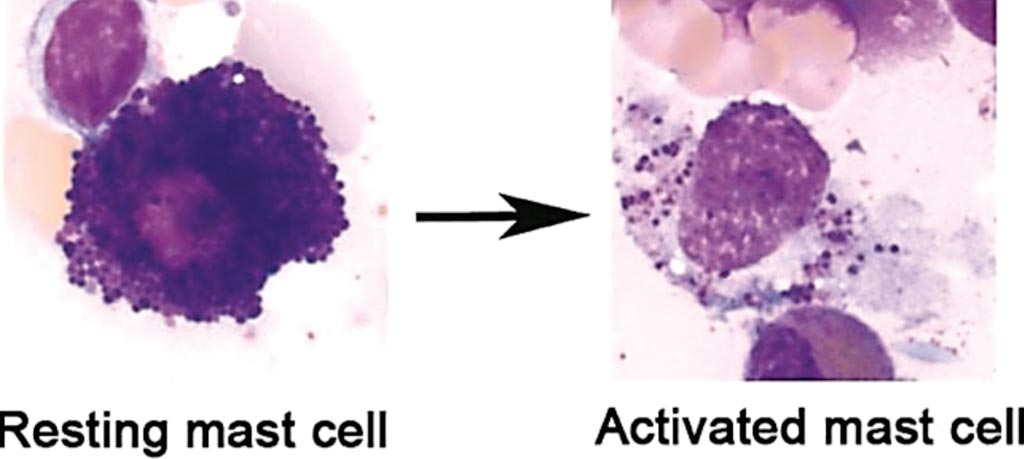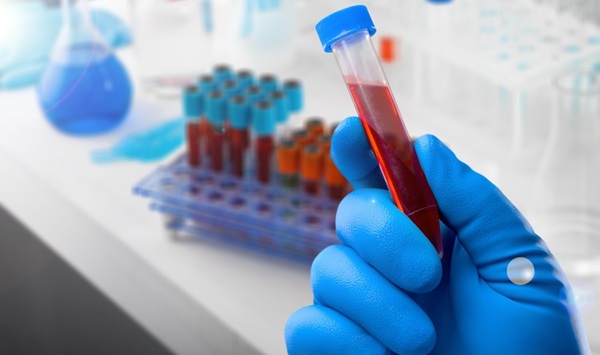Mast Cell Activation Test Diagnoses Allergic Diseases
|
By LabMedica International staff writers Posted on 16 May 2018 |

Image: Mast cells obtained from the human bone marrow; May-Grünwald/Giemsa stain of a resting human mast cell and a mast cell following activation-induced degranulation. Note the loss of granule staining (Photo courtesy of University Hospital of Bonn).
Peanut allergies are among the most common food allergies in children. Currently, doctors diagnose peanut allergy using a skin-prick test or immunoglobulin E (IgE) test, but this may result in over-diagnosis or false-positives and it cannot differentiate between sensitivity and true food allergy.
When skin-prick and IgE test results are unclear, allergists rely on an oral food challenge (OFC), which consists of feeding peanut in incrementally larger doses to a patient in a highly controlled setting in hospital to confirm allergy to the food. While the test is the gold standard for diagnosing food allergies, there is risk of causing severe allergic reactions.
Scientists at the University of Manchester (Manchester, UK) and their colleagues have developed a new laboratory test to diagnose peanut allergy. The team used blood samples from 174 children participating in allergy testing, 73 peanut allergic and 101 peanut-tolerant, the scientists added peanut protein to mast cells to screen for IgE-mediated activation. Levels of total IgE, peanut-specific IgE, and IgE to the recombinant allergen components were measured by using ImmunoCAP. Skin prick tests (SPTs) were undertaken according to national guidelines by using lancets and commercial peanut extract, with 1% histamine as a positive control. Images of mast cell activation were collected on an Olympus BX51 upright microscope.
The scientists found that human blood-derived mast cells (MCs) sensitized with sera from patients with peanut, grass pollen, and Hymenoptera (wasp venom) allergy demonstrated allergen-specific and dose-dependent degranulation, as determined based on both expression of surface activation markers (CD63 and CD107a) and functional assays (prostaglandin D2 and β-hexosaminidase release). In this cohort of peanut-sensitized subjects, the mast cell activation test (MAT) was found to have superior discrimination performance compared with other testing modalities, including component-resolved diagnostics and basophil activation tests. They identified five clusters or patterns of reactivity in the resulting dose-response curves, which at preliminary analysis corresponded to the reaction phenotypes seen at challenge.
The authors concluded that the MAT is a robust tool that can confer superior diagnostic performance compared with existing allergy diagnostics and might be useful to explore differences in effector cell function between basophils and MCs during allergic reactions. The study was published on March 5, 2018, in The Journal of Allergy and Clinical Immunology.
Related Links:
University of Manchester
When skin-prick and IgE test results are unclear, allergists rely on an oral food challenge (OFC), which consists of feeding peanut in incrementally larger doses to a patient in a highly controlled setting in hospital to confirm allergy to the food. While the test is the gold standard for diagnosing food allergies, there is risk of causing severe allergic reactions.
Scientists at the University of Manchester (Manchester, UK) and their colleagues have developed a new laboratory test to diagnose peanut allergy. The team used blood samples from 174 children participating in allergy testing, 73 peanut allergic and 101 peanut-tolerant, the scientists added peanut protein to mast cells to screen for IgE-mediated activation. Levels of total IgE, peanut-specific IgE, and IgE to the recombinant allergen components were measured by using ImmunoCAP. Skin prick tests (SPTs) were undertaken according to national guidelines by using lancets and commercial peanut extract, with 1% histamine as a positive control. Images of mast cell activation were collected on an Olympus BX51 upright microscope.
The scientists found that human blood-derived mast cells (MCs) sensitized with sera from patients with peanut, grass pollen, and Hymenoptera (wasp venom) allergy demonstrated allergen-specific and dose-dependent degranulation, as determined based on both expression of surface activation markers (CD63 and CD107a) and functional assays (prostaglandin D2 and β-hexosaminidase release). In this cohort of peanut-sensitized subjects, the mast cell activation test (MAT) was found to have superior discrimination performance compared with other testing modalities, including component-resolved diagnostics and basophil activation tests. They identified five clusters or patterns of reactivity in the resulting dose-response curves, which at preliminary analysis corresponded to the reaction phenotypes seen at challenge.
The authors concluded that the MAT is a robust tool that can confer superior diagnostic performance compared with existing allergy diagnostics and might be useful to explore differences in effector cell function between basophils and MCs during allergic reactions. The study was published on March 5, 2018, in The Journal of Allergy and Clinical Immunology.
Related Links:
University of Manchester
Latest Immunology News
- Molecular Microscope Diagnostic System Assesses Lung Transplant Rejection
- Blood Test Tracks Treatment Resistance in High-Grade Serous Ovarian Cancer
- Luminescent Probe Measures Immune Cell Activity in Real Time
- Blood-Based Immune Cell Signatures Could Guide Treatment Decisions for Critically Ill Patients
- Novel Tool Predicts Most Effective Multiple Sclerosis Medication for Patients
- Companion Diagnostic Test for CRC Patients Identifies Eligible Treatment Population
- Novel Tool Uses Deep Learning for Precision Cancer Therapy
- Companion Diagnostic Test Identifies HER2-Ultralow Breast Cancer and Biliary Tract Cancer Patients
- Novel Multiplex Assay Supports Diagnosis of Autoimmune Vasculitis
- Blood Test Predicts Immunotherapy Efficacy in Triple-Negative Breast Cancer
- Simple Genetic Testing Could Predict Treatment Success in Multiple Sclerosis Patients
- Novel Gene Signature Predicts Immunotherapy Response in Advanced Kidney Cancers
- New Technology Deciphers Immune Cell Communication to Predict Immunotherapy Response
- AI Model Accurately Predicts MSI Tumor and Immune Checkpoint Inhibitor Responsiveness
- Precision Tool Predicts Immunotherapy Treatment Failure in Melanoma Patients
- Paper-Based Device Accurately Detects Immune Defects in 10 Minutes
Channels
Clinical Chemistry
view channel
VOCs Show Promise for Early Multi-Cancer Detection
Early cancer detection is critical to improving survival rates, but most current screening methods focus on individual cancer types and often involve invasive procedures. This makes it difficult to identify... Read more
Portable Raman Spectroscopy Offers Cost-Effective Kidney Disease Diagnosis at POC
Kidney disease is typically diagnosed through blood or urine tests, often when patients present with symptoms such as blood in urine, shortness of breath, or weight loss. While these tests are common,... Read moreMolecular Diagnostics
view channel
Blood Test Could Predict Bariatric Surgery Outcomes in Teenagers
High blood pressure during adolescence increases the risk of lifelong cardiovascular disease, yet doctors still lack reliable tools to predict which young patients will benefit most from obesity treatments.... Read more
ctDNA Blood Test to Help Personalize Postsurgical Colon Cancer Treatment
For patients with Stage 3 colon cancer, current chemotherapy approaches are highly toxic and lack personalization. Standard treatment involves months of dual-agent chemotherapy, which often causes serious... Read moreHematology
view channel
Viscoelastic Testing Could Improve Treatment of Maternal Hemorrhage
Postpartum hemorrhage, severe bleeding after childbirth, remains one of the leading causes of maternal mortality worldwide, yet many of these deaths are preventable. Standard care can be hindered by delays... Read more
Pioneering Model Measures Radiation Exposure in Blood for Precise Cancer Treatments
Scientists have long focused on protecting organs near tumors during radiotherapy, but blood — a vital, circulating tissue — has largely been excluded from dose calculations. Each blood cell passing through... Read more
Platelets Could Improve Early and Minimally Invasive Detection of Cancer
Platelets are widely recognized for their role in blood clotting and scab formation, but they also play a crucial role in immune defense by detecting pathogens and recruiting immune cells.... Read more
Portable and Disposable Device Obtains Platelet-Rich Plasma Without Complex Equipment
Platelet-rich plasma (PRP) plays a crucial role in regenerative medicine due to its ability to accelerate healing and repair tissue. However, obtaining PRP traditionally requires expensive centrifugation... Read moreMicrobiology
view channel
Fast Noninvasive Bedside Test Uses Sugar Fingerprint to Detect Fungal Infections
Candida bloodstream infections are a growing global health threat, causing an estimated 6 million cases and 3.8 million deaths annually. Hospitals are particularly vulnerable, as weakened patients after... Read more
Rapid Sepsis Diagnostic Device to Enable Personalized Critical Care for ICU Patients
Sepsis is a life-threatening condition that occurs when the body’s response to infection spirals out of control, damaging organs and leading to critical illness. Patients often arrive at intensive care... Read morePathology
view channel
AI-Powered Method Combines Blood Data to Accurately Measure Biological Age
Chronological age tells us how many years we’ve lived, but not how quickly our bodies are ageing. Some people stay healthy well into their 80s or 90s, while others experience decline much earlier.... Read more
AI Tool Detects Cancer in Blood Samples In 10 Minutes
Detecting cancer recurrence or spread often depends on identifying rare tumor cells circulating in the bloodstream — a process known as a liquid biopsy. However, current methods rely on trained specialists... Read moreTechnology
view channel
Viral Biosensor Test Simultaneously Detects Hepatitis and HIV
Globally, over 300 million people live with Hepatitis B and C, and 40 million with HIV, according to WHO estimates. Diagnosing bloodborne viruses such as HIV and Hepatitis B and C remains challenging in... Read more
Acoustofluidic Device to Transform Point-Of-Care sEV-Based Diagnostics
Rapid and sensitive detection of small extracellular vesicles (sEVs)—key biomarkers in cancer and organ health monitoring—remains challenging due to the need for multiple preprocessing steps and bulky... Read moreIndustry
view channel
Advanced Instruments Merged Under Nova Biomedical Name
Advanced Instruments (Norwood, MA, USA) and Nova Biomedical (Waltham, MA, USA) are now officially doing business under a single, unified brand. This transformation is expected to deliver greater value... Read more









 assay.jpg)










